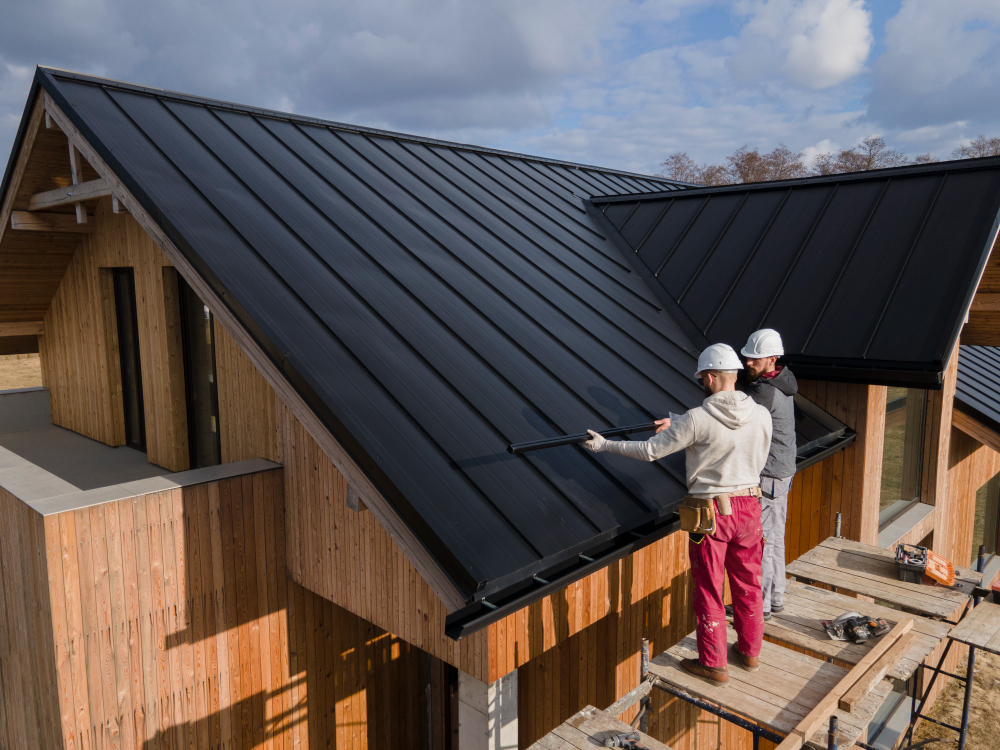Metal roofing has become a reliable and versatile choice for domestic, commercial and industrial buildings. This type of roofing is made of various metals like aluminium, copper, or zinc, and it is a modern, eco-friendly alternative to traditional roofing materials such as asphalt shingles, clay or concrete tiles.
This blog will cover:
- Brief history of metal roofing
- The types of metal roofing
- The benefits of metal roofing
- The difference between metal roofing and traditional roofing
A Brief History of Metal Roofing
Metal roofing has been around for centuries, dating back to ancient civilization. Here is a timeline highlighting its evolution:
Ancient Times: The earliest form of metal roofing was copper sheets used in temples and buildings.
18th and 19th Century: These sheets were developed during the American Revolutionary War, which started in 1738. Metal roofing gained prominence in Europe and North America, particularly for government and religious buildings. Zinc, lead, and copper were widely used.
20th Century: The Industrial Revolution and technological advancement introduced galvanized steel and aluminum, making metal roofing more accessible and cost-effective. The engraved metal gives the appearance of tile and keeps the building at a cooler temperature, and now, this is the most utilized procedure across the country.

Types Of Metal Roofing
Metal roofing comes in unique types, each with distinctive characteristics and applications:
Standing Seam Metal Roofing: It is a concealed raised steam fastener metal panel system that structures vertical legs and a smooth flat area rising above the panels of the flat area.
Benefits:
- Gives exceptional durability and longevity.
- Allows for thermal movement and watertight seams.
- Requires minimal maintenance.
Aluminium Metal Roofing: It is lightweight, making it ideal for places where weight is concerned, such as buildings near the coasts. It is corrosion-resistant and provides a protective coating that heals itself.
Benefits:
- Low maintenance
- It is long-lasting and comes in different categories: sheets, tiles, and panels.
Corrugated Metal Roofing: It works best to get rid of water quickly, and perhaps one of its best properties is its lightweight nature. It has twice the longevity of asphalt shingles.
Benefits:
- Less expensive
- Resists adverse weather conditions
Copper Metal Roofing: It is a strong, malleable metal with high thermal and electrical conductivity.
Benefits:
- Formed in different architectural appeals such as façade, cassettes and shingles.
- High antimicrobial properties and requires less maintenance.
- Easily recyclable and has minimal expansion during heat-thaw cycles.
Stone-Coated Metal Roofing: This roof combination combines steel’s versatile strengths with the look of traditional roofing material. It involves applying adhesive to unpainted metal surfaces and adding ceramic stone chips.
Benefits:
- Made up of natural materials such as granite and basalt, which come in different colours.
- Layers of stone granules act as a noise barrier, reducing the impact of noise on the roof.
- Lasts up to 50 years and provides lower energy costs.

Benefits of Metal Roofing
Metal roofing provides numerous advantages that make it the preferred choice for many property owners:
- It can last 40-70 years, far outlasting traditional materials.
- It works best for hail impacts with resistant properties against cracking, shrinking, and eroding.
- Metal roofs reflect solar heat, reducing cooling costs by up to 25%. They come with a coating that enhances reflectivity while enhancing your property’s energy efficiency.
- Versatile choice to reduce landfill waste and comes with maximum recyclable efficiency at the end of its life.
- Available in vast range of colours and textures to match architectural visible appeal.
- Withstand severe weather conditions, such as heavy snow and winds and protect against pest infestations.
- Metal roofs are fire resistant, providing you complete peace of mind.
- Lightweight and easy to install compared to conventional roofs.
Differences Between Metal Roofing & Traditional Roofing
Durability & Endurance:Metal roofing can last up to 70 years; copper and steel have the competence to last up to even more, while traditional roofing, such as asphalt, only lasts up to 20 years.
Weather Resilient: Metal roofs are strongly fire-resistant and can withstand extreme weather conditions, perfect for protection against wildfires. Traditional roofing is less adept at coping with weather conditions and can crack and lose granules.
Cost: Primarily, the cost range of metal roofing can be more expensive than traditional asphalt shingles but your investment gets paid off when its durability and longevity are considered.
Maintenance: Metal roofs are resistant to insect outbreaks and require occasional maintenance, compared to traditional roofs, such as clay tiles, which require more frequent maintenance.
Conclusion
Metal roofing combines a complex history, innovation, and practicality into one of today’s most reliable roofing solutions. Its numerous features, including durability and energy efficiency, make it an investment-worthy selection for residential and commercial property owners. At Rockford Coastal Homes, we emphasize the importance of understanding the different types of metal roofing and how they compare to traditional options. With this knowledge, you can make an informed decision that will enhance your roof’s longevity and raise the value of your property.


